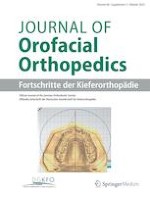Erschienen in:

28.09.2022 | Original Article
Soft tissue evaluation after maxillary protraction with RPE or with the ALT-RAMEC protocol
A controlled 3D study
verfasst von:
Assistant Prof. Elvan Onem Ozbilen, DDS Specialist in Orthodontics, Mustafa Onur Ari, DDS Specialist in Orthodontics, Associate Prof. Hanife Nuray Yilmaz, DDS PhD, Prof. Sibel Biren, DDS PhD
Erschienen in:
Journal of Orofacial Orthopedics / Fortschritte der Kieferorthopädie
|
Sonderheft 3/2023
Einloggen, um Zugang zu erhalten
Abstract
Purpose
To evaluate soft tissue changes following maxillary protraction with different expansion protocols using three-dimensional (3D) stereophotogrammetry.
Methods
Pretreatment (T0) and postprotraction (T1) stereophotogrammetry and lateral cephalometric images of skeletal class III patients were included in this retrospective study. In all, 32 patients were treated either with a combination of rapid palatal expansion and facemask (RPE/FM; n = 16; mean age: 9.94 ± 0.68 years) or with alternate rapid maxillary expansion and constriction together with a facemask (Alt-RAMEC/FM; n = 16; mean age: 9.74 ± 1.35 years). As a control group 16 untreated patients were recruited (mean age: 9.46 ± 0.8 years). For superimpositioning of the 3D images taken at T0 and T1, the face was divided into defined regions and 3D and differences between the groups were evaluated using 3‑matic software (Materialise Europe, Leuven, Belgium). Cephalometric analyses were also performed.
Results
While the increases in the cephalometric parameters SNA and ANB were significantly greater in the treatment groups, the value for SNB also increased in the control group (p < 0.05). The results of the stereophotogrammetry analyses demonstrated that the mean changes in the RPE/FM and in the Alt-RAMEC/FM groups were significantly different for the midface compared to the control group (0.33 ± 0.26 mm, 0.3 ± 0.31 mm, 0.1 ± 0.18 mm). The maximum positive, negative, and mean changes were also significantly different between the treatment and control groups for the upper lip (p < 0.05). For the lower lip and the chin significant backward movements in the RPE/FM as well as in the Alt-RAMEC/FM group (−1.06 ± 1.26 mm, −0.68 ± 0.45 mm) were observed, while the control group (0.09 ± 0.53 mm) presented changes in the opposite direction. Regarding soft tissue changes, no significant differences were found between the RPE/FM and Alt-RAMEC/FM groups.
Conclusion
Both treatment protocols improved the soft tissue profile due to a forward movement of the midface and the upper lip, and a backward movement of the lower lip and chin, compared to the control group.











